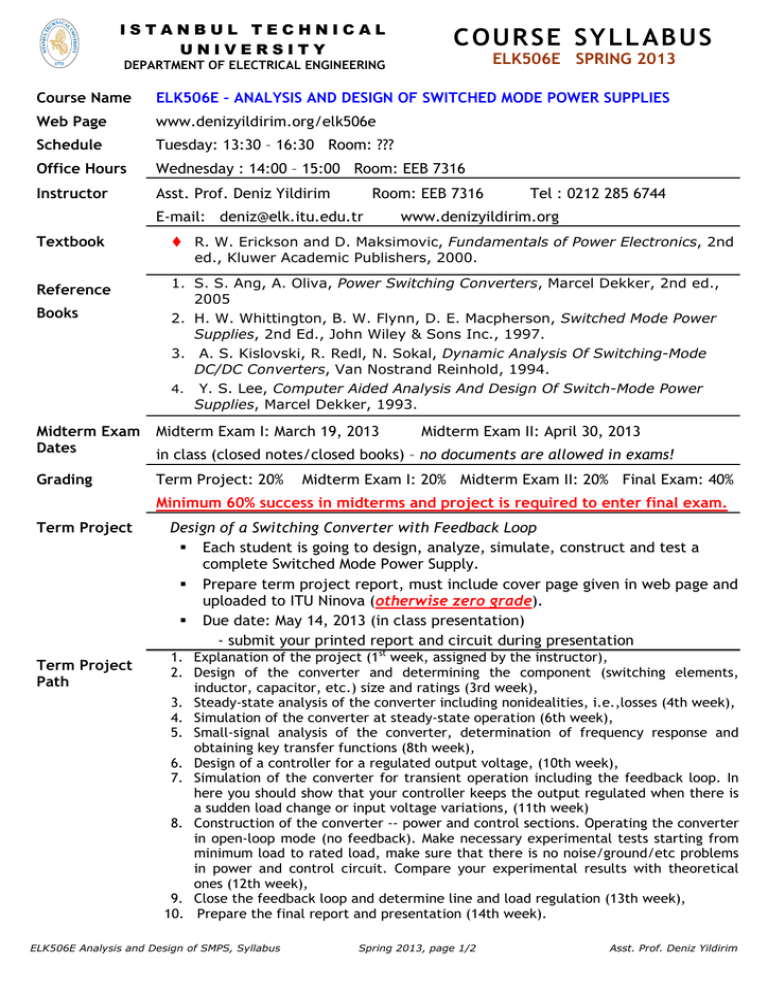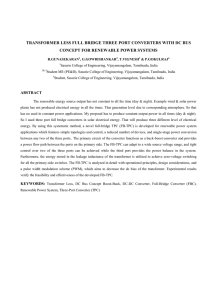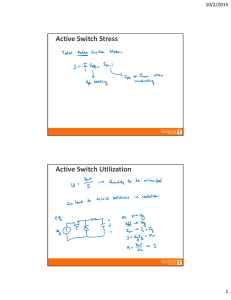COURSE SYLLABUS
advertisement

ISTANBUL TECHNICAL UNIVERSITY COURSE SYLLABUS ELK506E SPRING 2013 DEPARTMENT OF ELECTRICAL ENGINEERING Course Name ELK506E – ANALYSIS AND DESIGN OF SWITCHED MODE POWER SUPPLIES Web Page www.denizyildirim.org/elk506e Schedule Tuesday: 13:30 – 16:30 Room: ??? Office Hours Wednesday : 14:00 – 15:00 Room: EEB 7316 Instructor Asst. Prof. Deniz Yildirim Room: EEB 7316 E-mail: deniz@elk.itu.edu.tr Tel : 0212 285 6744 www.denizyildirim.org Textbook R. W. Erickson and D. Maksimovic, Fundamentals of Power Electronics, 2nd ed., Kluwer Academic Publishers, 2000. Reference 1. S. S. Ang, A. Oliva, Power Switching Converters, Marcel Dekker, 2nd ed., 2005 2. H. W. Whittington, B. W. Flynn, D. E. Macpherson, Switched Mode Power Supplies, 2nd Ed., John Wiley & Sons Inc., 1997. 3. A. S. Kislovski, R. Redl, N. Sokal, Dynamic Analysis Of Switching-Mode DC/DC Converters, Van Nostrand Reinhold, 1994. 4. Y. S. Lee, Computer Aided Analysis And Design Of Switch-Mode Power Supplies, Marcel Dekker, 1993. Books Midterm Exam Dates Midterm Exam I: March 19, 2013 Grading Term Project: 20% Midterm Exam II: April 30, 2013 in class (closed notes/closed books) – no documents are allowed in exams! Midterm Exam I: 20% Midterm Exam II: 20% Final Exam: 40% Minimum 60% success in midterms and project is required to enter final exam. Term Project Term Project Path Design of a Switching Converter with Feedback Loop Each student is going to design, analyze, simulate, construct and test a complete Switched Mode Power Supply. Prepare term project report, must include cover page given in web page and uploaded to ITU Ninova (otherwise zero grade). Due date: May 14, 2013 (in class presentation) - submit your printed report and circuit during presentation 1. Explanation of the project (1st week, assigned by the instructor), 2. Design of the converter and determining the component (switching elements, inductor, capacitor, etc.) size and ratings (3rd week), 3. Steady-state analysis of the converter including nonidealities, i.e.,losses (4th week), 4. Simulation of the converter at steady-state operation (6th week), 5. Small-signal analysis of the converter, determination of frequency response and obtaining key transfer functions (8th week), 6. Design of a controller for a regulated output voltage, (10th week), 7. Simulation of the converter for transient operation including the feedback loop. In here you should show that your controller keeps the output regulated when there is a sudden load change or input voltage variations, (11th week) 8. Construction of the converter -- power and control sections. Operating the converter in open-loop mode (no feedback). Make necessary experimental tests starting from minimum load to rated load, make sure that there is no noise/ground/etc problems in power and control circuit. Compare your experimental results with theoretical ones (12th week), 9. Close the feedback loop and determine line and load regulation (13th week), 10. Prepare the final report and presentation (14th week). ELK506E Analysis and Design of SMPS, Syllabus Spring 2013, page 1/2 Asst. Prof. Deniz Yildirim ISTANBUL TECHNICAL UNIVERSITY COURSE SYLLABUS DEPARTMENT OF ELECTRICAL ENGINEERING Weekly Course Outline (tentative) ELK506E SPRING 2013 1. Principals of steady state converter analysis 2. Steady state equivalent circuit modeling, losses and efficiency 3. DC transformer model, switch realization and power semiconductor devices 4. The discontinuos conduction mode operation of converters 5. Converter topologies 6. Magnetics theory, loss mechanism in magnetic devices, eddy currents in winding conductors, several types of magnetic devices 7. Filter inductor design constraints, multiple-winding magnetics design Transformer design constraints, AC inductor design 8. AC equivalent circuit modeling of converters, state-space averaging 9. Review of Bode plots, analysis of converter transfer functions 10. Graphical construction of impedances and converter transfer functions, effect of negative feedback on the network transfer functions 11. Closed loop transfer functions and stability 12. Closed loop transfer functions and stability 13. Regulator design, lead, lag, lead-lag controllers, 14. Regulator design, measurement of loop gains Course Objective Course Learning Outcomes Switched Mode Power Supplies (SMPS) are power electronic circuits that perform power conversion by operating a semiconductor switch in on-off mode at high frequencies. Because of containing low loss elements (capacitor, inductor, transformer, semiconductor switch), high efficiency, low weight and small size make these supplies to be wide spread used in today's many applications. The aim of this course is to give mathematical tools for steady-state and dynamic analysis. The necessary tools required in the design of SMPS such as magnetic elements and controllers are also the scope of this course. 1. Steady-state analysis of switched mode power supply, 2. Equivalent circuit modeling for a switching power supply, 3. Design of magnetic components (i.e., inductor and transformer) in a converter, 4. Determination of selection criteria for component semiconductors and controller IC in a converter 5. Derivation of control-to-output transfer function and plotting frequency response of converter, 6. Feedback controller design for regulated output voltage. values, power Additional Remarks ELK506E Analysis and Design of SMPS, Syllabus Spring 2013, page 2/2 Asst. Prof. Deniz Yildirim



